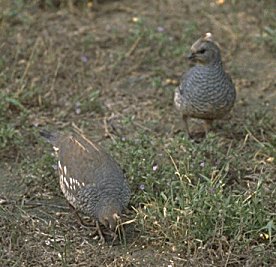
Callipepla: from Greek kallipeplos meaning "beautifully adorned"; formed from kalos meaning "beautiful" and peplos meaning "a ceremonial robe".
squamata: Latin for "scale-like".
Scaled: describes the plumage pattern.
Quail: derived from the Middle Dutch quackel which means "quail".

Other names:
Cotton Top, Scaled Partridge; Chestnut-bellied Scaled Partridge, Blue Quail, Scaley Colin, Mexican Quail. Spanish: Codorniz Escamosa.
Systematics:
Class: Aves; Order: Galliformes; Family: Odontophoridae.
Key Identification Characters:
Blue-gray scaly appearance to breast and neck plumage, buff-white crest ("cotton top"); juveniles grayish brown above with black and brown spots, buff colored below with brown bars and white spots; male and female similar. Length, 10"; wingspan, 14".
Fig. 1. Scaled Quail. Photograph by Dr. Lloyd Glenn Ingles, © 2001 California Academy of Sciences.
Distribution:
Southwestern United States to central Mexico.
El Paso Region: common desert resident
Food:
Mainly plant material, including sorgum, snakeweed, catclaw acacia; animal material consumed in larger quantities than in other North American quail (especially in spring and summer), includes beetles, grasshoppers, ants, true bugs, spiders.
Breeding:
Number of eggs/clutch: range 8 to 16; egg: creamy white, finely specked with buff or pale brown; 1.25" x 0.95"; nesting: shallow hollow in ground under bush or cactus.
American Ornithologists' Union. 1983. Check-list of North American birds, 6th ed. Allen Press, Lawrence, 877 pp.
Bologna, G. 1978. Simon and Schuster guide to birds of the world. Simon and Schuster, New York, 511 pp.
Cassidy, J., ed. 1990. Book of North American birds. Reader's Digest, New York, 576 pp.
Ehrlich, P., D. S. Dobkin, and D. Wheye. 1988. The birder's handbook. Simon and Schuster, New York, 785 pp.
Johnsgard, P. A. 1973. Grouse and quails of North America. University of Nebraska Press, Lincoln, 553 pp.
Contributor: Scott M. Cutler, Centennial Museum Curator of Collections and Exhibits; Laboratory for Environmental Biology Curator of Ornithology.
Last update: 30 Jul 2009